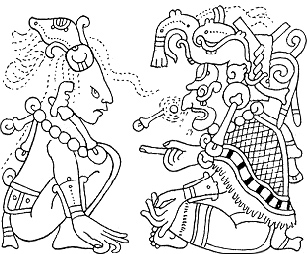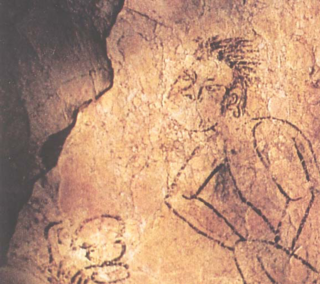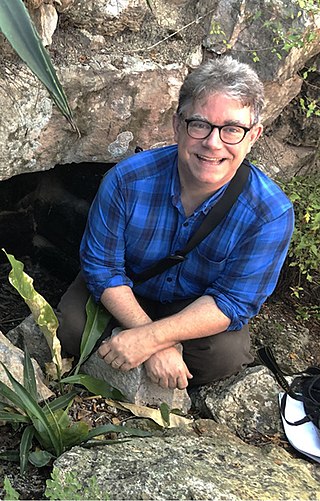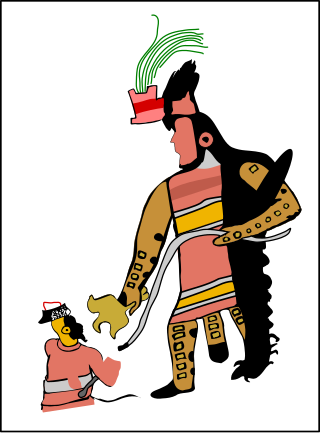
Palenque, also anciently known in the Itza Language as Lakamhaʼ, was a Maya city state in southern Mexico that perished in the 8th century. The Palenque ruins date from ca. 226 BC to ca. 799 AD. After its decline, it was overgrown by the jungle of cedar, mahogany, and sapodilla trees, but has since been excavated and restored. It is located near the Usumacinta River in the Mexican state of Chiapas, about 130 km south of Ciudad del Carmen, 150 meters (490 ft) above sea level. It averages a humid 26°C (79°F) with roughly 2,160 millimeters (85 in) of rain a year.

Chin, together with Cu, Cavil, and Maran, is mentioned as the name of the male deity said to have demonstrated sexual intercourse with other male deities and humans.

Chalcatzingo is a Mesoamerican archaeological site in the Valley of Morelos dating from the Formative Period of Mesoamerican chronology. The site is well known for its extensive array of Olmec-style monumental art and iconography. Located in the southern portion of the Central Highlands of Mexico, Chalcatzingo is estimated to have been settled as early as 1500 BCE. The inhabitants began to produce and display Olmec-style art and architecture around 900 BCE. At its height between 700 BCE and 500 BCE, Chalcatzingo's population is estimated at between five hundred and a thousand people. By 500 BCE it had gone into decline. The climate in Morelos is generally warmer and more humid than the rest of the Highlands. The Chalcatzingo center covers roughly 100 acres (0.40 km2). Evidence indicates that this was a site of ritual significance.

World trees are a prevalent motif occurring in the mythical cosmologies, creation accounts, and iconographies of the pre-Columbian cultures of Mesoamerica. In the Mesoamerican context, world trees embodied the four cardinal directions, which also serve to represent the fourfold nature of a central world tree, a symbolic axis mundi which connects the planes of the Underworld and the sky with that of the terrestrial realm.

Maya architecture spans several thousands of years, several eras of political change, and architectural innovation before the Spanish colonization of the Americas. Often, the buildings most dramatic and easily recognizable as creations of the Maya peoples are the step pyramids of the Terminal Preclassic Maya period and beyond. Based in general Mesoamerican architectural traditions, the Maya utilized geometric proportions and intricate carving to build everything from simple houses to ornate temples. This article focuses on the more well-known pre-classic and classic examples of Maya architecture. The temples like the ones at Palenque, Tikal, and Uxmal represent a zenith of Maya art and architecture. Through the observation of numerous elements and stylistic distinctions, remnants of Maya architecture have become an important key to understanding their religious beliefs and culture as a whole.

The traditional Maya or Mayan religion of the extant Maya peoples of Guatemala, Belize, western Honduras, and the Tabasco, Chiapas, Quintana Roo, Campeche and Yucatán states of Mexico is part of the wider frame of Mesoamerican religion. As is the case with many other contemporary Mesoamerican religions, it results from centuries of symbiosis with Roman Catholicism. When its pre-Hispanic antecedents are taken into account, however, traditional Maya religion has already existed for more than two and a half millennia as a recognizably distinct phenomenon. Before the advent of Christianity, it was spread over many indigenous kingdoms, all with their own local traditions. Today, it coexists and interacts with pan-Mayan syncretism, the 're-invention of tradition' by the Pan-Maya movement, and Christianity in its various denominations.

Mesoamerican architecture is the set of architectural traditions produced by pre-Columbian cultures and civilizations of Mesoamerica, traditions which are best known in the form of public, ceremonial and urban monumental buildings and structures. The distinctive features of Mesoamerican architecture encompass a number of different regional and historical styles, which however are significantly interrelated. These styles developed throughout the different phases of Mesoamerican history as a result of the intensive cultural exchange between the different cultures of the Mesoamerican culture area through thousands of years. Mesoamerican architecture is mostly noted for its pyramids, which are the largest such structures outside of Ancient Egypt.

Ancient Maya art is the visual arts of the Maya civilization, an eastern and south-eastern Mesoamerican culture made up of a great number of small kingdoms in present-day Mexico, Guatemala, Belize and Honduras. Many regional artistic traditions existed side by side, usually coinciding with the changing boundaries of Maya polities. This civilization took shape in the course of the later Preclassic Period, when the first cities and monumental architecture started to develop and the hieroglyphic script came into being. Its greatest artistic flowering occurred during the seven centuries of the Classic Period.

Tortuguero is an archaeological site in southernmost Tabasco, Mexico which supported a Maya city during the Classic period. The site is noteworthy for its use of the B'aakal emblem glyph also found as the primary title at Palenque. The site has been heavily damaged by looting and modern development; in the 1960s, a cement factory was built directly on top of the site.
Prisoner's cinema is the phenomenon of a "light show" of various colors that appear out of the darkness. The light has a form, but those that have seen it find it difficult to describe. Sometimes, the cinema lights resolve into human or other figures.

Naj Tunich is a series of pre-Columbian era natural caves outside the village of La Compuerta, roughly 35 km east of Poptún in Guatemala. The site was a Maya ritual pilgrimage site during the Classic period. Artifacts show that the cave was accessed primarily during the Early Classic period. Deposits become rarer during the Late Classic period. The fame of the cave, however, rests on its long Late Classic hieroglyphic texts as well as on a considerable number painted scenes and figures.

Like other Mesoamerican peoples, the traditional Maya recognize in their staple crop, maize, a vital force with which they strongly identify. This is clearly shown by their mythological traditions. According to the 16th-century Popol Vuh, the Hero Twins have maize plants for alter egos and man himself is created from maize. The discovery and opening of the Maize Mountain – the place where the corn seeds are hidden – is still one of the most popular of Maya tales. In the Classic period, the maize deity shows aspects of a culture hero.

Karl Andreas Taube is an American Mesoamericanist, Mayanist, iconographer and ethnohistorian, known for his publications and research into the pre-Columbian cultures of Mesoamerica and the American Southwest. He is Distinguished Professor of Anthropology at the College of Humanities, Arts, and Social Sciences, University of California, Riverside. In 2008 he was named the College of Humanities, Arts, and Social Sciences distinguished lecturer.

David S. Stuart is an archaeologist and epigrapher specializing in the study of ancient Mesoamerica, the area now called Mexico and Central America. His work has studied many aspects of the ancient Maya civilization. He is widely recognized for his breakthroughs in deciphering Maya hieroglyphs and interpreting Maya art and iconography, starting at an early age. He is the youngest person ever to receive a MacArthur Fellowship, at age 18. He currently teaches at the University of Texas at Austin and his current research focuses on the understanding of Maya culture, religion and history through their visual culture and writing system.

JuxtlahuacaSpanish pronunciation:[xuʃtɬaˈwaka] is a cave and archaeological site in the Mexican state of Guerrero containing murals linked to the Olmec motifs and iconography. Along with the nearby Oxtotitlán cave, Juxtlahuaca walls contain the earliest sophisticated painted art known in Mesoamerica, and only known example of non-Maya deep cave art in Mesoamerica.

The Feathered Serpent is a prominent supernatural entity or deity, found in many Mesoamerican religions. It is still called Quetzalcoatl among the Aztecs, Kukulkan among the Yucatec Maya, and Q'uq'umatz and Tohil among the K'iche' Maya.

Mayan cave sites are associated with the Mayan civilization of pre-Columbian Mesoamerica. Beliefs and observances connected with these cave sites persist among some contemporary Mayan communities. Many of the Mayan caves served religious purposes. For this reason, the artifacts found there, alongside the epigraphic, iconographic, and ethnographic studies, help build the modern-day understanding of the Mayan religion and society.
Cacahuaziziqui is a pre-Columbian cave site containing Olmec paintings. It is located in the Mexican province of Guerrero on the southern coast of the country. The site is located 30 miles west of Oxtotitlan and Juxtlahuaca and southeast of Tlapa, a mountainous area in the Guerrero state. The Guerrero caves are often located in remote canyons.

The Temple of the Cross Complex is a complex of temples at the Maya site of Palenque in the state of Chiapas in Mexico. It is located in the south-east corner of the site and consists of three main structures: the Temple of the Cross, Temple of the Sun, and the Temple of the Foliated Cross. The Temple of the Cross is the largest and most significant. The temple is a step pyramid containing bas-relief carvings inside. The temple was constructed to commemorate the rise of Chan Bahlum II to the throne after the death of Pacal the Great. The bas-relief carvings reveal Chan Bahlum receiving the great gift from his predecessor. The cross motif found at the complex allude to the names given to the temples, but in reality the cross is a representation to the World Tree that can be found in the center of the world according to Mayan mythology.

Yopaat was an important Maya storm god in the southern Maya area that included the cities of Copán and Quiriguá during the Classic period of Mesoamerican chronology. Yopaat was closely related to Chaac, the Maya rain god. Yopaat is depicted as bearing a flint weapon that represents a thunderbolt. Yopaat was held responsible for especially violent lightning storms, that were believed to cause earthquakes. He was often represented with a snake in place of one leg, demonstrating a close relationship with Kʼawiil, another Maya deity with similar attributes.














